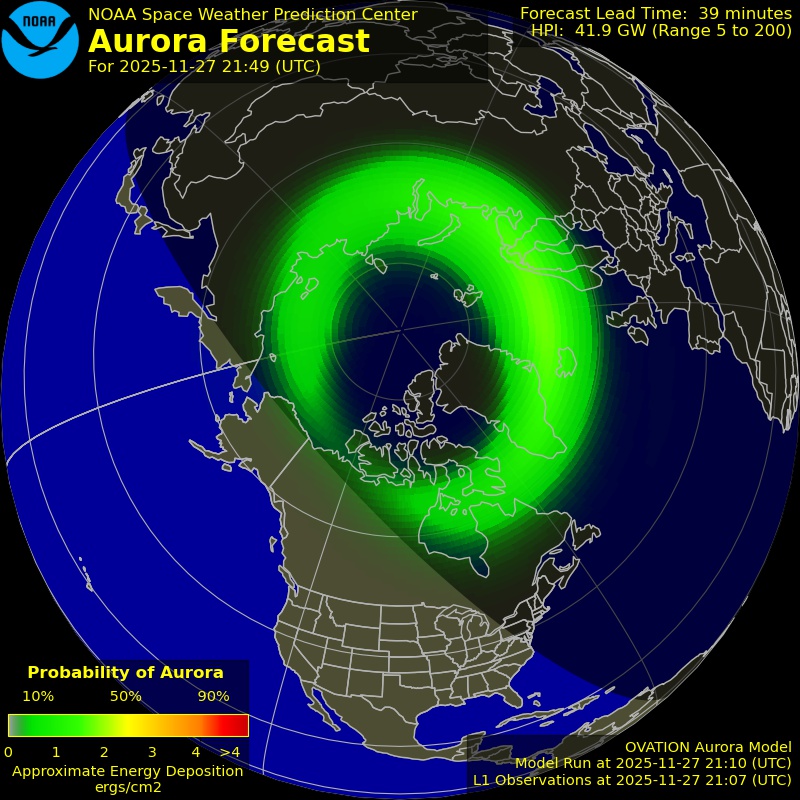Southern Lights Forecast for Tasmania
Substorm
Substorm Phase: Quiet; Aurora Activity Score: 15/100
Ideal Conditions for Southern Lights in Tasmania:
Power: +48Gw | Bz: -11 | Wind Speed: 400+ | Density: 4+ | Kp: 6+
If the data above meets or exceeds the power meets then the Aurora Australis should be visible in most of Tasmania.
Don’t Miss the Magic!
Stay ahead of the Northern Lights with real-time alerts. Subscribe now to receive a text or call whenever the aurora is active—so you never miss a moment of the show.
How to use this data:
Tasmania, the picturesque island state of Australia, offers a remarkable opportunity to witness the mesmerizing Aurora Australis, also known as the Southern Lights.
Our team gathers live satellite data and compiles it into a user-friendly dashboard, filtering out unnecessary noise to provide you with clear and concise information. However, we understand that understanding this data might be overwhelming. Follow our simple “how-to” guide to gain more insights.
Utilize our long-range forecast to plan your trip well in advance, ensuring you don't miss the awe-inspiring Southern Lights. Combine it with our more localized minute-to-minute insights to optimize your chances of experiencing this breathtaking natural phenomenon to the fullest.

Where to see the Southern Lights in Tasmania?
In Tasmania, the best place to see the Aurora Australis, or Southern Lights, is along the southern coast of the island, away from major light pollution. The southernmost regions of Tasmania offer a higher chance of witnessing this mesmerizing natural phenomenon. Specifically, the areas near and around the following locations are popular for aurora sightings:
- Mount Wellington: Rising above the city lights, Mount Wellington provides an exceptional vantage point for observing the night sky. From this elevated position, you may have a chance to witness and photograph the mesmerizing Aurora Australis.
- South Arm Peninsula: Located southeast of Hobart, the South Arm Peninsula provides dark skies and relatively low light pollution, making it a suitable spot for observing the Southern Lights.
- Tasman Peninsula: The rugged landscapes and remote areas of the Tasman Peninsula offer excellent opportunities for aurora viewing. Places like Eaglehawk Neck and Fortescue Bay are often recommended for witnessing the auroras.
- Bruny Island: Bruny Island, situated off the southeastern coast of Tasmania, provides relatively dark skies and a tranquil environment for experiencing the Southern Lights.
- Cockle Creek: Located at the southernmost point of Tasmania, Cockle Creek is a remote and beautiful area where visitors have a good chance of seeing the auroras.
- Huon Valley: The Huon Valley, south of Hobart, offers secluded spots with minimal light pollution, increasing the likelihood of aurora sightings.
- Lake St Clair: In the heart of the Tasmanian Wilderness World Heritage Area, Lake St Clair is surrounded by pristine wilderness, offering a stunning backdrop for aurora watching.
When can you see Southern Lights in Tasmania?
The best time of day to see the Aurora Australis (Southern Lights) in Tasmania is typically during the late evening to the early morning hours. The auroras are a natural light display caused by solar particles interacting with the Earth's atmosphere, and they are most visible in the dark night sky.
As a result Aurora Admin will usually recommends aurora viewing between the hours of 11:00 PM to 3:00 AM the next morning.
When is the best time of year to see the Aurora Australis in Tasmania?
The Aurora Australis, can be observed in Tasmania during periods of robust solar activity and under clear, dark skies. Due to longer periods of darkness, this natural spectacle is more likely to occur frequently during the winter months, spanning from April to September. However, it is essential to note that sightings are not guaranteed.
The optimal opportunities for viewing the Aurora Australis in Tasmania are typically from May to August. During these months, the nights are longer and darker, creating more favorable conditions for witnessing the mesmerizing display.
To enhance the chances of experiencing the Aurora Australis in Tasmania, it is advisable to exercise patience, monitor real-time aurora forecasts, and explore areas away from city lights. Venturing to darker and less light-polluted locations will significantly improve the visibility of this captivating natural phenomenon throughout the island of Tasmania.
Is it possible to witness the Southern Lights in Tasmania tonight?
The possibility of witnessing the Aurora Australis tonight depends on the incoming data. To stay informed with the most accurate updates, closely monitor Aurora Admin for real-time information. If the specified criteria align, there is a good chance of experiencing the Southern Lights in Tasmania tonight.
How long do the Southern Lights usually last?
The duration of the Southern Lights, also known as the Aurora Australis, can vary. On average, a single display of the Southern Lights may last anywhere from a few minutes to several hours. However, in some cases, particularly during periods of heightened solar activity, the aurora can persist for several hours or even extend into the night. The exact duration of the aurora depends on factors such as the intensity of the solar storm, atmospheric conditions, and the overall strength of the aurora display. Keep in mind that while some auroras are brief, others can provide a prolonged and awe-inspiring spectacle.
What to Expect When Viewing Aurora?
When witnessing the aurora, images often showcase a mesmerizing array of dazzling colors; however, the naked eye may only detect white flashes or flickering that could be misconstrued as clouds, while capturing the vivid colors requires a long camera exposure. Notably, observing the aurora in Tasmania with the naked eye becomes possible when the Kp-index reaches 7.
Aurora Oval
Northern Hemisphere

Looking for a more accurate Forecast? We alos have Aurora predictions for Hobart.
